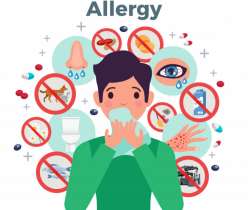Allergy reactions are hypersensitivity of the immune system to some substances present in the environment. These substances which cause allergic reactions are known as allergens. When an individual comes in contact with the allergens (causes of allergy), the allergic reactions occur. The reactions include hay fever, food allergies, atopic dermatitis, allergic asthma, and anaphylaxis. Symptoms which appear after allergic reactions are red eyes, an itchy rash, sneezing, a runny nose, shortness of breath, or swelling. One can get rid of an allergy reaction by eliminating the causes of allergy from his/her body.
These are the most common things which trigger an allergic reaction: –
- Dust mites- these are microscopic things which are seen by microscope only. They cause an allergic reaction. The allergic reaction is treated with nasal sprays, antihistamines, or decongestants. Prevention methods are as follows are-
- Put dust mite covers over the bedding
- Prefer using hypoallergenic pillows
- Wash bed sheets and sofa covers weekly in hot water
- Keep all areas of your home, especially the bedroom, free of stuff that collects dust, such as stuffed animals, curtains, and carpet.
- Mold- molds are tiny fungi with spores that are present in the air like pollen. They born in damp areas such as basements or bathrooms and piles of leaves or grass. The person when comes in contact with molds they experience sneezing, congestion, itchy and watery eyes, runny nose, and coughing. Treatment is similar to dust mite’s treatment. Preventive methods are-
- Avoid mold and eliminate such things from your house that encourage their growth.
- don’t keep plants inside because soil can hold the molds
- while raking leaves in the fall, wear a mask
- Animal dander and cockroaches- dander are flecks of skin shed by cats, dogs, and even birds. Dander triggers allergies. Some people also react to the proteins from oil glands in an animal’s skin or proteins from an animal’s saliva. It may take two years or more to develop an allergy like this. It may make you experience symptoms including sneezing, congestion, and itchy and watery eyes. Prevention methods are
- Stay away from animals that cause allergies.
- wash your pet every week
- There are some medications like antihistamines, decongestants, and nasal steroids to help. Immunotherapy might also help.
- If you have cockroaches’ allergies, be sure to keep trash in closed containers and take it out of your home promptly.
- Insect sting- if something stung you and you are having an allergic reaction to it. Stay away insects like bees, fire ants, yellow jackets, hornets, and wasps. After the sting from these insects, you can experience pain, swelling, and redness and heat around the sting site. These symptoms can last for a few days. Sometimes people get a dangerous, full-body reaction called anaphylaxis, which needs emergency treatment of allergies. Symptoms of anaphylaxis are as follows-
- trouble breathing
- becoming hoarse
- wheezing
- swelling around the face, eyelids, ears, mouth, hands or feet
- feeling dizzy or passing out
- belly cramps, nausea, vomiting, or diarrhea
If you are allergic to insects:
- keep insecticide handy, always wear shoes outdoors, and stay from outdoor garbage
- Avoid wearing bright colored clothes and using scented cosmetics
- Talk to your doctor about allergy shots, and they help prevent anaphylaxis.
Also Read: Keep your Eyes Allergy-Free with these Simple Steps
After getting stung by an insect do this
- Try to remove the stinger of the insect. Take an oral antihistamine drug to reduce itching, swelling and hives
- Try a pain reliever and use an icepack in order to reduce dull pain caused by the sting. Some people prefer taking corticosteroids to curb swelling and inflammation
- Food- there are some foods which may cause an allergic reaction. Allergic reaction from food happens just after a few minutes of eating that food. These allergies can be severe and mild. Some people have a life-threatening anaphylactic response from peanuts, so they must avoid peanut in their diet. Fish, shellfish, nuts, soybeans, wheat, milk, and eggs are among the most common foods that cause allergies.
- Latex- some people have an allergic reaction to latex such present in gloves, condoms, or other things. During the latex allergy reactions, these symptoms appear
- teary, irritated eyes
- runny nose
- wheezing
- sneezing
It’s less common, but some people can have anaphylaxis from latex. For the treatment of allergies use antihistamines. Preventive methods are staying away from latex
- wear a bracelet that leads people to know you have a latex allergy
- Consult your doctor immediately if you have an anaphylactic reaction and use an epinephrine auto-injector.



